Landscapes by Rubens
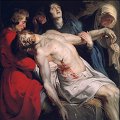 The Flemish and European
Baroque painter Peter Paul Rubens was the
most renowned northern European artist of his day, and is now widely
recognized as one of the foremost painters in Western art history. He
was the proponent of the Baroque style which emphasized
movement, color, and sensuality. By completing
the fusion of the realistic tradition of Flemish painting with the
imaginative freedom and classical themes of Italian Renaissance
painting, he fundamentally revitalized and redirected northern
European painting.
The Flemish and European
Baroque painter Peter Paul Rubens was the
most renowned northern European artist of his day, and is now widely
recognized as one of the foremost painters in Western art history. He
was the proponent of the Baroque style which emphasized
movement, color, and sensuality. By completing
the fusion of the realistic tradition of Flemish painting with the
imaginative freedom and classical themes of Italian Renaissance
painting, he fundamentally revitalized and redirected northern
European painting.
- Return of the Prodigal Son (1618)
- Landscape with Saint George and the Dragon (1630)
- An Autumn Landscape with a View of Het Steen (1635)
- Landscape with a Rainbow (1635)
- Tournament in front of Castle Steen (1637)
- Landscape with a Rainbow (1638)
Return of the Prodigal Son (1618)
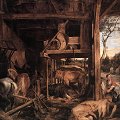 Get
Get  a high-quality picture of
Return of the Prodigal Son for your computer or notebook. ‣
When Rubens died in 1640, he still possessed his Prodigal Son of 1618. Amongst his many grand altarpieces and dramatic mythological subjects, the creation of this rural scene, intended for his own living room, must have given him a great deal of pleasure. The biblical subject - depicted bottom right - serves merely as a vehicle for the painting of one of his earliest landscapes.
a high-quality picture of
Return of the Prodigal Son for your computer or notebook. ‣
When Rubens died in 1640, he still possessed his Prodigal Son of 1618. Amongst his many grand altarpieces and dramatic mythological subjects, the creation of this rural scene, intended for his own living room, must have given him a great deal of pleasure. The biblical subject - depicted bottom right - serves merely as a vehicle for the painting of one of his earliest landscapes.
Landscape with Saint George and the Dragon (1630)
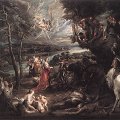 Get
Get  a high-quality picture of
Landscape with Saint George and the Dragon for your computer or notebook. ‣
Saint George and the Dragon symbolises the close relationship established between Rubens and the court of Charles I. The subject honours the patron saint of England and of the Order of the Garter, founded by Edward III in 1348. The features of Saint George are traditionally stated to be those of Charles I, while the figure of the Empress Cleodelinde is, according to the same tradition, intended to be Queen Henrietta Maria. The verdant landscape is also a form of flattery in so far as it is inspired by the English countryside. Indeed, the background was described by Croft-Murray as 'probably Rubens's single essay in English landscape.' Some of the buildings are identifiable, although their contiguity is purely imaginary. On the left of the composition, for example, is the square church tower of St Mary Overy (now Southwark Cathedral) and to the right of this possibly the Banqueting House with Westminster Abbey before Hawksmoor's towers were added. Further down river on the right of the composition is an interpretation of Lambeth Palace.
a high-quality picture of
Landscape with Saint George and the Dragon for your computer or notebook. ‣
Saint George and the Dragon symbolises the close relationship established between Rubens and the court of Charles I. The subject honours the patron saint of England and of the Order of the Garter, founded by Edward III in 1348. The features of Saint George are traditionally stated to be those of Charles I, while the figure of the Empress Cleodelinde is, according to the same tradition, intended to be Queen Henrietta Maria. The verdant landscape is also a form of flattery in so far as it is inspired by the English countryside. Indeed, the background was described by Croft-Murray as 'probably Rubens's single essay in English landscape.' Some of the buildings are identifiable, although their contiguity is purely imaginary. On the left of the composition, for example, is the square church tower of St Mary Overy (now Southwark Cathedral) and to the right of this possibly the Banqueting House with Westminster Abbey before Hawksmoor's towers were added. Further down river on the right of the composition is an interpretation of Lambeth Palace.
The canvas was extended by the artist, evidently sometime between 1630 and 1635. These additions betoken extensive rethinking of the design. The original concept was to have been contained within the central section and is recorded in a drawing in Stockholm (National Museum). This was preceded by a study in Berlin of motifs occurring in the right half of the composition. These drawings show that the horseman on the right was at first balanced on the left by a woman standing with a child, forms which can still be discerned between the trunks of the two trees and which are even more obvious by X-ray. They were omitted, however, when the composition was enlarged, possibly because they did not constitute a sufficiently strong counterpoint. The other elements of the composition, especially on the right, were merely rearranged on a broader scale. It is conceivable that some iconographical refinements were also made in order to sharpen the allegorical meaning. What remains of this central part is of good quality, particularly the flickering evening light and damp atmosphere so characteristic of the Thames Valley, and can be assigned to Rubens himself. The additions, however, are less adroitly handled and may have been left to studio assistants. The initial composition perhaps relates to the engraving of the same subject by Lucas van Leyden. The works of Pordenone, Titian, Polidoro da Caravaggio, Veronese and the Carracci family all inspired the artist in carrying out this political allegory which, in the context of the reign of Charles I, clearly has religious connotations with particular reference to Saint George.
An Autumn Landscape with a View of Het Steen (1635)
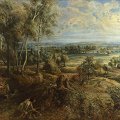 Get
Get  a high-quality picture of
An Autumn Landscape with a View of Het Steen for your computer or notebook. ‣
At the end of his life, Rubens's art tended to be meditative. His favourite dwelling-place was a country-house just outside Antwerp, from which his gaze could lose itself in the limitless calm of the Flemish plain.
a high-quality picture of
An Autumn Landscape with a View of Het Steen for your computer or notebook. ‣
At the end of his life, Rubens's art tended to be meditative. His favourite dwelling-place was a country-house just outside Antwerp, from which his gaze could lose itself in the limitless calm of the Flemish plain.
Landscape with a Rainbow (1635)
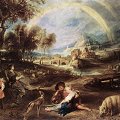 Get
Get  a high-quality picture of
Landscape with a Rainbow for your computer or notebook. ‣
This painting displays the spirit of pastoral literature rather directly, which is emphasized by the Italianate appearance. This is obvious in the figures, the mountain view in the background and the architecture of the buildings.
a high-quality picture of
Landscape with a Rainbow for your computer or notebook. ‣
This painting displays the spirit of pastoral literature rather directly, which is emphasized by the Italianate appearance. This is obvious in the figures, the mountain view in the background and the architecture of the buildings.
Tournament in front of Castle Steen (1637)
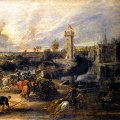 Get
Get  a high-quality picture of
Tournament in front of Castle Steen for your computer or notebook. ‣
In his last years Rubens spent the summer months in his country residence, Het Steen, at Elewijt, between Mechelen and Brussels, which he had acquired in August of 1634. There he painted the largest and most luminous landscapes of his entire career; Landscape with Rainbow and Tournament in front of Castle Steen, the latter featuring a wholly imaginary joust. They show us complementary views of a countryside pullulating with human, animal and plant life. They are odes in paint to the natural order of creation, an Arcadian vision of man living in harmony with nature. At Het Steen, Rubens enjoyed the fruits of his long and industrious career, but he also added a new facet to his reputation and ensured his historical influence as a landscape painter. We might cite, in particular, the landscapes of Constable.
a high-quality picture of
Tournament in front of Castle Steen for your computer or notebook. ‣
In his last years Rubens spent the summer months in his country residence, Het Steen, at Elewijt, between Mechelen and Brussels, which he had acquired in August of 1634. There he painted the largest and most luminous landscapes of his entire career; Landscape with Rainbow and Tournament in front of Castle Steen, the latter featuring a wholly imaginary joust. They show us complementary views of a countryside pullulating with human, animal and plant life. They are odes in paint to the natural order of creation, an Arcadian vision of man living in harmony with nature. At Het Steen, Rubens enjoyed the fruits of his long and industrious career, but he also added a new facet to his reputation and ensured his historical influence as a landscape painter. We might cite, in particular, the landscapes of Constable.
Landscape with a Rainbow (1638)
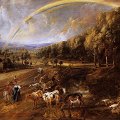 Get
Get  a high-quality picture of
Landscape with a Rainbow for your computer or notebook. ‣
Rubens painted this picture at the end of his life when he was living in his country residence at Het Steen. The contrast between the two halves of the composition, a sunlit prosperity on the left and a gloomy wood on the right, suggest an analogy with the Last Judgment, the rainbow representing the Arc of the Covenant.
a high-quality picture of
Landscape with a Rainbow for your computer or notebook. ‣
Rubens painted this picture at the end of his life when he was living in his country residence at Het Steen. The contrast between the two halves of the composition, a sunlit prosperity on the left and a gloomy wood on the right, suggest an analogy with the Last Judgment, the rainbow representing the Arc of the Covenant.
The late landscapes by Rubens, such as this work, with their atmospheric appearance, often in subdued golden light of an early summer evening, make an elegiac impression. This makes Rubens come close to the spirit of Titian who exercised such a profound influence on his other late work.
Peter Paul Rubens Art
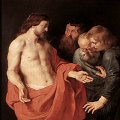
|
|
More
Articles
 Art Encyclopedia A world history of art in articles.
Art Encyclopedia A world history of art in articles.
Baroque
Peter Paul Rubens
Art and life. Biography.
Early mythological paintings.
Late mythological paintings.
Early religious paintings.
Late religious paintings.
Portraits.
Landscapes.
Art
 Art Wallpapers Art image collections for your desktop.
Art Wallpapers Art image collections for your desktop.
Caravaggio Art, $25
(100 pictures)
Rubens Art, $29
(200 pictures)
Rembrandt Art, $25
(160 pictures)

